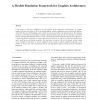Free Online Productivity Tools
i2Speak
i2Symbol
i2OCR
iTex2Img
iWeb2Print
iWeb2Shot
i2Type
iPdf2Split
iPdf2Merge
i2Bopomofo
i2Arabic
i2Style
i2Image
i2PDF
iLatex2Rtf
Sci2ools
EGH
2004
Springer
2004
Springer
A flexible simulation framework for graphics architectures
In this paper we describe a multipurpose tool for analysis of the performance characteristics of computer graphics hardware and software. We are developing Qsilver, a highly configurable micro-architectural simulator of the GPU that uses the Chromium system’s ability to intercept and redirect an OpenGL stream. The simulator produces an annotated trace of graphics commands using Chromium, then runs the trace through a cycle-timer model to evaluate time-dependent behaviors of the various functional units. We demonstrate the use of Qsilver on a simple hypothetical architecture to analyze performance bottlenecks, to explore new GPU microarchitectures, and to model power and leakage properties. One innovation we explore is the use of dynamic voltage scaling across multiple clock domains to achieve significant energy savings at almost negligible performance cost. Finally, we discuss how other architectural features and experiments might be incorporated into the Qsilver framework. Catego...
Related Content
| Added | 01 Jul 2010 |
| Updated | 01 Jul 2010 |
| Type | Conference |
| Year | 2004 |
| Where | EGH |
| Authors | Jeremy W. Sheaffer, David P. Luebke, Kevin Skadron |
Comments (0)

